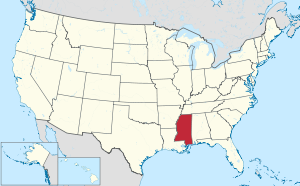
Back مقاطعة هولمز (ميسيسيبي) Arabic Holmes County, Mississippi BAR Холмс (окръг, Мисисипи) Bulgarian হোলমস কাউন্টি, মিসিসিপি BPY Holmes Gông (Mississippi) CDO Холмс (гуо, Миссисипи) CE Holmes County (kondado sa Tinipong Bansa, Mississippi) CEB Holmes County, Mississippi Welsh Holmes County (Mississippi) Danish Holmes County (Mississippi) German
Holmes County | |
|---|---|
 | |
 Location within the U.S. state of Mississippi | |
 Mississippi's location within the U.S. | |
| Coordinates: 33°07′N 90°05′W / 33.12°N 90.09°W | |
| Country | |
| State | |
| Founded | 1833 |
| Named for | David Holmes |
| Seat | Lexington |
| Largest city | Durant |
| Area | |
| • Total | 765 sq mi (1,980 km2) |
| • Land | 757 sq mi (1,960 km2) |
| • Water | 7.9 sq mi (20 km2) 1.0% |
| Population (2020) | |
| • Total | 17,000 |
| • Density | 22/sq mi (8.6/km2) |
| Time zone | UTC−6 (Central) |
| • Summer (DST) | UTC−5 (CDT) |
| Congressional district | 2nd |
| Website | holmescountyms |
Holmes County is a county in the U.S. state of Mississippi; its western border is formed by the Yazoo River and the eastern border by the Big Black River. The western part of the county is within the Yazoo-Mississippi Delta. As of the 2020 census, the population was 17,000.[1] Its county seat is Lexington.[2] The county is named in honor of David Holmes, territorial governor and the first governor of the state of Mississippi and later United States Senator for Mississippi.[3] Holmes County native, Edmond Favor Noel, was an attorney and state politician, elected as governor of Mississippi, serving from 1908 to 1912.
Cotton was long the commodity crop; before the Civil War, its cultivation was based on slave labor and the majority of the population consisted of enslaved African Americans.[4] Planters generally developed their properties along the riverfronts. After the war, many freedmen acquired land in the bottomlands of the Delta by clearing and selling timber to raise the purchase price, but most lost their land during difficult financial times at the end of the century, becoming tenant farmers or sharecroppers.[5] With an economy based on agriculture, the county had steep population declines from 1940 to 1970, due to mechanization of farm labor, and the second wave of the Great Migration. African Americans migrated from the Deep South especially to West Coast cities, where jobs were plentiful in the buildup of the defense industry.
Some African Americans had reacquired land in Holmes County in the 1940s under New Deal programs. By 1960, Holmes County's 800 independent black farmers owned 50% of the land, a higher number of such farmers than elsewhere in the state.[6] They were integral members of the Civil Rights Movement during the 1960s. In 1967, eight of ten black candidates to run for local county office were landowning farmers; they were the first African Americans to run for office in the county since Reconstruction. Holmes had more candidates running for offices for the Freedom Democratic Party than did any other county.[7]
Robert G. Clark, Jr., a teacher in Holmes County, was elected as state representative in 1967, the first black person to be elected to state government in the 20th century. He served as the only African American in the state house until 1976. He continued to be re-elected to the state legislature from Holmes County until 2003. In the late 20th century, he was elected to the first of three terms as Speaker of the state House.
- ^ "Census - Geography Profile: Holmes County, Mississippi". United States Census Bureau. Retrieved January 8, 2023.
- ^ "Find a County". National Association of Counties. Archived from the original on May 31, 2011. Retrieved June 7, 2011.
- ^ Gannett, Henry (1905). The Origin of Certain Place Names in the United States. Govt. Print. Off. pp. 159.
- ^ Wilson, Charles Reagan (October 10, 2017). "Black Belt/Prairie". Mississippi Encyclopedia. Retrieved August 23, 2020.
The Mississippi Black Belt is part of a larger region, stretching from Virginia south to the Carolinas and west through the Deep South, defined by a majority African American population and a long history of cotton production.
- ^ "Dwindling Black Farmers Fight Formidable Odds for Future : Agriculture: Small operations, particularly those owned by African-Americans, are disappearing. Their numbers have declined from one-seventh in 1920 to less than 1% today". Los Angeles Times. December 30, 1990. ISSN 0458-3035. Retrieved May 3, 2019.
- ^ Cite error: The named reference
lorenziwas invoked but never defined (see the help page). - ^ Sojourner with Reitan (2013), Thunder of Freedom, p. 242
© MMXXIII Rich X Search. We shall prevail. All rights reserved. Rich X Search